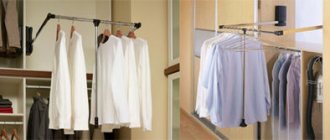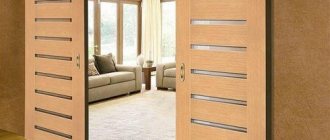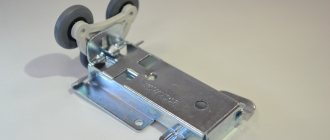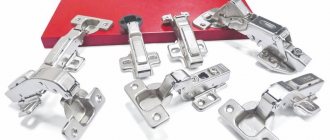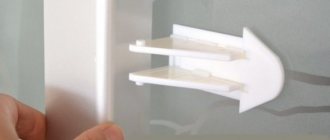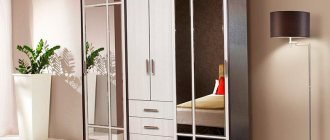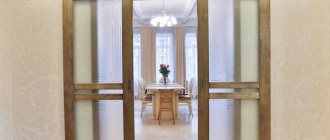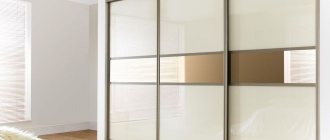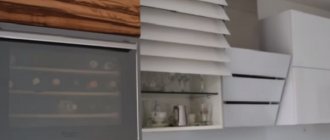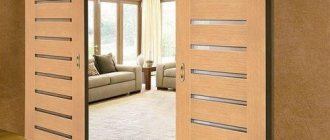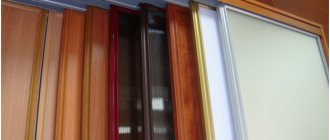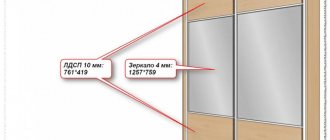A wardrobe is a storage unit with sliding doors. The movement of the valves is carried out using a mechanism consisting of many parts. One of these components is the guides on which the doors run. Let's consider the types of profiles, their technical characteristics, materials and installation rules in the cabinet. A summary table of ratings of popular companies and models will help you buy good guides.
Purpose and equipment
The doors move along guides, like a train on rails. The sliding mechanism system includes:
- guides;
- moving rollers;
- closers ensuring smooth closing;
- silicone seals and brushes;
- mounting screws, screws;
- stoppers;
- retainers.
A set of fittings for the assembly and installation of sliding doors.
All these components together form a single mechanism for sliding doors, which allows them to move only in two directions - right and left. Rail profiles are made of metal and plastic. Additional elements are purchased for them: stoppers, rollers, seals.
Guides vary in weight, size and materials. When purchasing a ready-made cabinet, door profiles are always included in the kit, so there is no need to select them separately. But in the event of a breakdown, you will need to purchase new elements.
Types of guides for sliding wardrobe doors: installation options
The design of guides for sliding sliding doors includes various components and parts, the main function of which is to ensure the movement of various elements of furniture structures. For example, they ensure free (without jamming) sliding of the doors of various types of cabinets.
Today, two systems of guide mechanisms are most common:
- door, which include several design varieties; for extending box structures - table drawers, sofa trays, tabletop extensions and shelving.
Types of systems by design
There are two main types of sliding wardrobe systems: hanging and supporting.
Suspended structures place load on the upper rollers. In support systems, the main weight of the doors falls on the lower profile.
The single hanging mechanism on which the doors are mounted is located at the top of the cabinet. Over time, the canvas may become loose. To prevent this, you need to install a stabilizer.
Support system - rollers move only along the bottom guide. The door is secured at the top with special clamps. By changing the height of the wheels it is easy to adjust the tilt of the doors.
The main disadvantage is that dirt and dust get into the runners, which causes the rollers to wear out quickly. This can be avoided by securing belt brushes or regular manual cleaning.
The combined system combines both types. The movement of the shutters is carried out by the upper and lower wheels. This is the modern and most popular mechanism.
A special feature are coplanar systems, which allow the door leaves to be positioned in one plane (flush), and when opened, they first move slightly forward and then move left and right. These are the most modern and expensive mechanisms.
Installing a stopper (latch)
The stopper is needed to ensure that the door is fixed in the closed position and held tightly without forming a gap with the touching side.
How to install
Install them in the groove of the lower guide (where the wheel goes), one stopper for each door.
We insert one stopper into each groove, screw the bottom guide, install the doors and adjust the latches, ensuring a tight closure.
In order to accurately place the lock in the right place, completely close the compartment doors and mark the center of the wheel on the guide below, and install the stop there, centered on the mark. You can move the stopper in the groove with a flat screwdriver.
Materials
Three main types of guide profiles are distributed in retail chains:
- Aluminum. High-quality and expensive components. They are lightweight and highly durable. Can withstand doors of any weight and width. They are easy to cut.
- Steel. Durable, reliable, inexpensive. The correct selection of furniture parameters is required. Heavy, difficult to cut and adjust. Steel guides are difficult to install.
- Plastic. The cheapest fragile profiles with a short service life. Plastic should be combined with metal elements.
It is best to buy aluminum guides depending on the parameters of the furniture.
Varieties
Furniture fittings for cabinets include various devices to expand the functionality of products and play an important role in ensuring the comfort and durability of interior items. The components differ not only in cost and quality characteristics. Lifting and sliding mechanisms have their own design features.
Rollers
The standard kit for a wardrobe with sliding doors includes casters. They ensure the movement of the sashes along the housing strip. Some models have special bearings that prevent noise. There are two options for rollers:
- Asymmetrical. Mounted on open profiles, the sash support when moving is concentrated on the lower wheel. The upper part is supportive.
- Symmetrical. Used in designs for glass doors, plastic and mirror facades with closed handles. The lower and upper movement mechanisms are equally involved.
According to the type of design, rollers are divided into rotary and non-rotary. The first allow you to comfortably use interior items and move them around the room without effort. The latter can withstand significant loads, but are not suitable for frequent movements.
Asymmetrical
Symmetrical
Rotary
Fixed
Guides
The parts consist of two parts: one is installed on the top panel, the other at the bottom. The door leaf moves between them. There are three types of guides:
- single-lane;
- two-way;
- three-way.
Folding door tracks are available in plastic, aluminum or steel. When choosing, take into account the maximum permissible load on the fittings. Fragile products cannot be used for massive doors.
Single-lane
Two-way
Three-way
Plastic
Aluminum
Steel
Profiles
These elements form the frame of the door leaf. Vertical profiles additionally serve as handles. They produce two types of products:
- Steel, from sheets 0.3-0.8 mm thick. They are classified as an economy option, they are not rigid enough, and the color choice is limited.
- Aluminum, belonging to the expensive segment. They are durable, tough, and come in any color.
To ensure silent operation of cabinet doors, you should choose aluminum profiles coated with PVC. Used to make doors up to 320 cm high.
Types and characteristics of furniture hinges, fastening rules
Steel
Aluminum
Stopper
The stopper is attached to the lower guide. When the sash opens, the roller gets between the plates and blocks the door. When choosing a stopper, preference is given to a durable steel product. You can ignore it when there are no more than two doors. Otherwise, operating the cabinet without this type of fittings will become unsafe.
Sliding system
Sliding type systems are basic. Thanks to these mechanisms, the doors move. They produce two types of fittings:
- support ones, consisting of a pair of guides, rollers and a profile;
- suspension systems that include a top guide, a roller carriage and a stopper.
The sliding mechanism is selected depending on the dimensions of the door leaves, the material of manufacture, and the opening option. Support systems fit large doors. It is not necessary to frame the canvas with a profile on hanging fittings.
Support
Hanging
Sealant
The exact fit of the door to the body depends on correctly selected seals. They can be silicone or polyurethane
It is important to choose a reliable, easy-to-use option. Types of seals:
- U-shaped - for facades made of plastic, glass, mirror, less often aluminum profiles with a thickness of 4 mm, 8 mm;
- herringbone type - a special type of design, installed for glass doors.
Schlegel is glued to the grooves of the vertical guides. A soft brush softens the impact of the door leaf on the body. The service life of furniture is extended thanks to seals.
Polyurethane
U-shaped
By type of Christmas tree
Schlegel
Decorative coating
Aluminum ones are additionally anodized to provide additional protective properties and a beautiful appearance. In this case, the metal is chemically painted. During the operation, pigment particles penetrate deeply into the aluminum structure. Thanks to this, the decorative coating is especially durable, resistant to scratches, abrasion, fading and moisture.
Variety of colors and textures of aluminum profiles
An aluminum profile, which is wrapped in a protective thin layer of PVC, is very durable, moisture-resistant, and wear-resistant.
The steel profile is most often painted. Colored steel coating is not wear resistant. Over time, it cracks and peels off.
Staining methods
There are several ways to decorate profiles. The main ones are:
- Anodizing. The essence of this method is to create an oxide layer. It gives the profile a beautiful appearance, prevents abrasion and tarnishing, makes the material waterproof, and strengthens its properties.
- Quartzization. Mainly used as an auxiliary method. Using brush grinding, thoroughly clean the part.
- Cataphoresis. Repeated treatment of the profile with chemical agents ensures an ideal coating without pores or unevenness. After such procedures, the surface becomes smooth and shiny.
- Wrapping in PVC. Allows you to create different textures and increases resistance to mechanical damage.
- Veneering. The profile is covered with a wood layer. Ideal for adding texture to a variety of rocks. Varnish is applied to the finished veneer.
Standard sizes of sliding wardrobes, their internal contents
Anodizing
Cataphoresis
PVC film
Veneering
How to choose a good model?
Pay attention to the following criteria to avoid mistakes when purchasing:
- The quality of the material affects the noise level when moving the rollers and the durability of the system.
- The price depends on the manufacturer. Those that are too cheap may bend under the weight of the doors or corrode due to poor metal processing. But it’s not always worth overpaying for a brand. Domestic analogues have similar characteristics and are several times cheaper.
- Choosing the right size will make installation easier.
- The compatibility of the fittings is important - the type of roller must match the guide. Buy wheels and profile as a set from one company or interchangeable analogues.
- You can save on guides, but positioners and rollers must be of high quality, for example, from Raum+.
- The most expensive products are from Aristo. Analogues from Dorwell, Premium or Grandis are half the price, but are not much inferior in quality.
- Aristo has several profiles with different prices: “ECO”, “RF” (economy). Some companies also have “light” models. This is a lightweight foil-type profile, which is manufactured at the expense of quality at low prices. Its thickness is less than the recommended 1.2 mm.
- The Versailles brand does not exist. This is the name given to all Chinese products without identification marks or markings.
